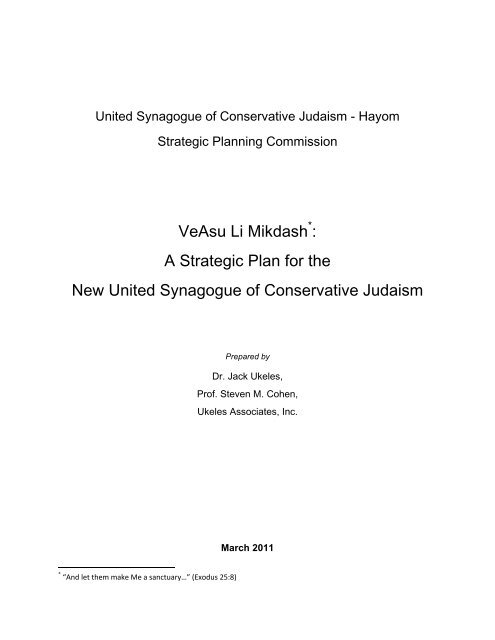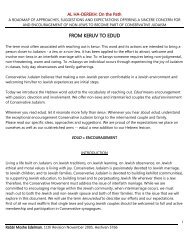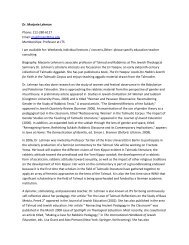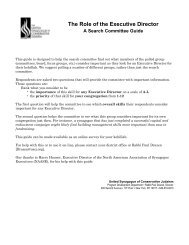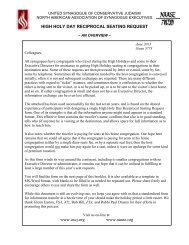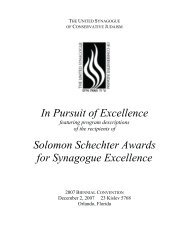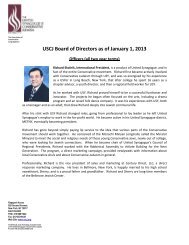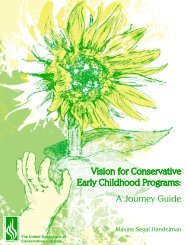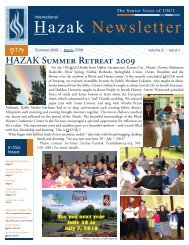Strategic Plan - United Synagogue of Conservative Judaism
Strategic Plan - United Synagogue of Conservative Judaism
Strategic Plan - United Synagogue of Conservative Judaism
Create successful ePaper yourself
Turn your PDF publications into a flip-book with our unique Google optimized e-Paper software.
<strong>United</strong> <strong>Synagogue</strong> <strong>of</strong> <strong>Conservative</strong> <strong>Judaism</strong> - Hayom<strong>Strategic</strong> <strong>Plan</strong>ning CommissionVeAsu Li Mikdash * :A <strong>Strategic</strong> <strong>Plan</strong> for theNew <strong>United</strong> <strong>Synagogue</strong> <strong>of</strong> <strong>Conservative</strong> <strong>Judaism</strong>Prepared byDr. Jack Ukeles,Pr<strong>of</strong>. Steven M. Cohen,Ukeles Associates, Inc.March 2011* “And let them make Me a sanctuary…” (Exodus 25:8)
Commission MembersDr. Jacob Finkelstein, Co-Chair, Rochester, New YorkRabbi Ed Feinstein, Co-Chair, Encino, CaliforniaCantor Jack Chomsky, Columbus, OhioRabbi Menachem Creditor, Berkeley, CaliforniaEddie Edelstein, Baldwin, New YorkNed Gladstein, Caldwell, New JerseyRichard Helfand, Leawood, KansasRabbi Debra Newman Kamin, Chicago, IllinoisAlisa Rubin Kurshan, New York, New YorkHoward Lesner, Los Angeles, CaliforniaMargie Pomerantz, Los Gatos, CaliforniaAlan Weissman, Ranchos Palos Verdes, CaliforniaDr. Marilyn Wind, Bethesda, MarylandRichard Skolnik, Bellmore, New York, USCJ International PresidentRabbi Michael Siegel, Chicago, Illinois, Hayom ChairpersonRabbi Steven Wernick, New York, New YorkUSCJ Executive Vice President and CEOUAI Consulting TeamDr. Jacob B. (“Jack”) UkelesPr<strong>of</strong>. Steven M. CohenDr. Ron MillerAri Roskies
Transmittal LetterDear Friends,We are pleased to submit the enclosed strategic plan for consideration and adoption by theBoard <strong>of</strong> Directors <strong>of</strong> the <strong>United</strong> <strong>Synagogue</strong> <strong>of</strong> <strong>Conservative</strong> <strong>Judaism</strong> and for consideration bythe members <strong>of</strong> Hayom. The <strong>Plan</strong> was approved unanimously by the USJC-Hayom <strong>Plan</strong>ningCommission at its final meeting on March 4 th .A draft <strong>of</strong> this document was created as a result <strong>of</strong> extensive deliberations <strong>of</strong> the USCJ-Hayom<strong>Strategic</strong> <strong>Plan</strong>ning Commission and was supported by research, analysis, and consultations bythe UAI team led by Dr. Jacob Ukeles and Pr<strong>of</strong>. Steven M. Cohen. The draft has been refinedand revised in light <strong>of</strong> extensive input from stakeholders over the last month -- more than 500emails and nearly 1,000 face-to-face contacts in meetings, online Webinars and focus groups.Through this process many voices were heard. Of course, this is a consensus documentdeliberated on by a commission, thus all suggestions for change in language or content weresubject to discussion and review and not all were eventually adopted and passed by the group.Some participants in this review process suggested that the new language <strong>of</strong> “kehilla” isconfusing or opaque. Of course, most members <strong>of</strong> the USCJ will continue to refer to themselvesas congregations or synagogues. The <strong>Plan</strong> recognizes this, but it is important that we constantlyremind ourselves <strong>of</strong> what synagogues are – that is, Jewish sacred communities, and that wewelcome less formal Jewish sacred communities such as chavurot or minyanim as well as themore established form <strong>of</strong> sacred community – the synagogue.As described in the document, we, the Commission, feel that <strong>Conservative</strong> <strong>Judaism</strong> in NorthAmerica is at a crossroads. We must focus serious effort on strengthening and transforming thesynagogue, which is the primary institution <strong>of</strong> our communal Jewish life.We should be clear that this is a strategic plan for a new USCJ. It is not a plan for <strong>Conservative</strong><strong>Judaism</strong> or the other leading organizations and bodies identified with <strong>Conservative</strong> <strong>Judaism</strong>. Atthe same time, we believe it is impossible to separate the future <strong>of</strong> USCJ from the future <strong>of</strong><strong>Conservative</strong> <strong>Judaism</strong>. To be successful, USCJ needs to forge a powerful strategic alliancewith the other leading centers <strong>of</strong> <strong>Conservative</strong> <strong>Judaism</strong> in North America.Please keep in mind that the purpose <strong>of</strong> this plan is to create a framework for a new USCJ.While it proposes an overall strategy and direction, it is not meant to provide the specifics. Adocument like this sets goals and describes parameters within which an organization shouldfunction. We envision an aggressive implementation process, starting immediately as soon asthe plan is approved and lasting from two to three years.We close by thanking all the members <strong>of</strong> the Commission and the consultants for theirextraordinary dedication and commitment to this process. We began many months ago with agoal in mind but no sense <strong>of</strong> the path we would take to reach it. As the process evolved thegroup found the means to grow together to articulate what you have before you. We also wantto thank everyone who made the effort to engage in the review <strong>of</strong> the draft plan. The input wereceived was extremely valuable in creating the best possible plan for USCJ.Dr. Jacob FinkelsteinRabbi Ed FeinsteinCo-Chairs, USCJ-Hayom <strong>Strategic</strong> <strong>Plan</strong>ning Committee
<strong>Strategic</strong> <strong>Plan</strong>
The Case for a New <strong>United</strong> <strong>Synagogue</strong> <strong>of</strong> <strong>Conservative</strong> <strong>Judaism</strong>Two critical considerations undergird the case for a new USCJ: the necessity <strong>of</strong> a vital<strong>Conservative</strong> <strong>Judaism</strong> in North America and the importance <strong>of</strong> having <strong>Conservative</strong>congregations that are both inspiring and well-functioning.<strong>Conservative</strong> <strong>Judaism</strong>For nearly a century, <strong>United</strong> <strong>Synagogue</strong> has been one <strong>of</strong> the organizations leading<strong>Conservative</strong> <strong>Judaism</strong>. <strong>Conservative</strong> <strong>Judaism</strong> is the essential anchor <strong>of</strong> the vitalreligious center <strong>of</strong> North American Jewry.No clear boundaries or bright markers define this vital religious center, a segment that ispivotal to the future <strong>of</strong> North American Jewry. This center can be discerned by thefollowing signs and tendencies. Jews in the center:• Attach great importance to being Jewish and to <strong>Judaism</strong> as a religion.• Marry other Jews and have mostly Jewish friends.• Prefer egalitarian prayer, conducted largely in Hebrew.• Favor social engagement that has a distinctively Jewish take on the world.• Value Jewish text learning.This group spans the spectrum from the left fringes <strong>of</strong> Orthodoxy to the right fringes <strong>of</strong>Reform, and it includes serious post-denominational Jews. But the vast majorityexplicitly identify with <strong>Conservative</strong> <strong>Judaism</strong>. Because people in this group, even whenthey do intermarry, tend to raise their children as Jews, this group enjoys relative highlevels <strong>of</strong> Jewish demographic staying power.In the coming years, this vital religious center can become stronger and more vibrant,serving as the fulcrum <strong>of</strong> Jewish life in North America. Alternatively, it can decline andfade away, with its people shifting to the left or to the right in an increasingly bifurcatedNorth American Jewish world.<strong>Conservative</strong> <strong>Judaism</strong> faces a number <strong>of</strong> well-documented challenges that must beovercome. These include an aging constituency, long-term decline in numbers <strong>of</strong> selfidentified<strong>Conservative</strong> Jews, and decrease in denominational identification by sometalented and innovative young Jewish leaders.The absolute number <strong>of</strong> <strong>Conservative</strong> Jews in North America, and their share <strong>of</strong>congregationally affiliated Jews have been declining since the 1960s. The reasons aremultiple. First, the number <strong>of</strong> non-Orthodox North American Jews between 25 and 44years old is shrinking relative to those between 55 and 74.The number <strong>of</strong> in-marriedyoung couples is shrinking as well, with commensurate growth <strong>of</strong> non-married andintermarried Jews. Second, <strong>Conservative</strong> Jews today are older, on average, than
Reform, Orthodox, Reconstructionist, post-denominational, or non-denominationalJews. Over the years, losses to <strong>Conservative</strong> identity have been <strong>of</strong>fset in part bycommensurate gains for Orthodoxy, post-denominational, non-denominational, andsecular identities.The challenges are not only demographic but cultural as well. Religious identities aremore fluid. Over the years, North American Jews have shifted from identities <strong>of</strong>belonging and affiliation to identities <strong>of</strong> purpose and meaning – that is, in line with largersocietal trends, younger Jews in particular are less invested in institutions, boundaries,and explicit norms, and more interested in the high quality and relevance <strong>of</strong> theirexperiences.Many Jews in their 20s and 30s appear to be averse to being labeled or categorized.Therefore, by definition, many are not interested in being part <strong>of</strong> a “movement” orhaving a Jewish denominational label such as “<strong>Conservative</strong>.” Many young people whogrew up in the <strong>Conservative</strong> movement are migrating to post-denominational or modernOrthodox settings. They are creating a numerically small but culturally significantresurgence <strong>of</strong> Jewish life in five areas: communities <strong>of</strong> prayer, self-directed learning,culture, social justice, and new media.<strong>Conservative</strong> CongregationsCongregations remain the single most important institutional focus <strong>of</strong> Jewish life inNorth America. Even with declining membership, more Jews in North America belongto congregations than to any other form <strong>of</strong> Jewish institution or organization.A strong and vibrant religious center for North American Jewry requires strong andvibrant <strong>Conservative</strong> congregations. <strong>Conservative</strong> congregations must overcomefinancial stress, declining and aging membership, a narrow leadership base, weakdenominational commitment, and a loss <strong>of</strong> meaning for many younger people.Concerns for the future <strong>of</strong> <strong>Conservative</strong> congregations have been palpable and growingover the last decade. In a 2006 USCJ-sponsored survey, congregational leadersexpressed their concerns and anxieties, which centered around four Ms: members,money, movement, and meaning.In a study conducted in mid-2010, one quarter <strong>of</strong> <strong>Conservative</strong> congregational leadersreport their congregations to be in serious financial difficulty; and another quarter reportsome difficulty. 1 In contrast, five years ago only 8 percent were in serious financialdifficulty. In 2010, only 9 percent <strong>of</strong> adult members <strong>of</strong> <strong>Conservative</strong> congregations wereunder 40. Only 13 percent <strong>of</strong> <strong>Conservative</strong> leaders report that their congregations1 FACT Study, 2010; computations performed by UAI.
experience “a lot” <strong>of</strong> rotation in leadership roles. Only 24 percent <strong>of</strong> <strong>Conservative</strong>leaders strongly agree that their congregation “celebrates their denominationalheritage.”The USCJ can and must play a pivotal role in realizing the potential <strong>of</strong> <strong>Conservative</strong>congregations and overcoming these challenges.USCJ has 652 affiliated congregations with 204,000 membership units. 44 percent <strong>of</strong>these congregations have fewer than 200 members; they account for only 14 percent <strong>of</strong>membership units. The 46 largest congregations, representing 7 percent <strong>of</strong> the membersynagogues, account for 25 percent <strong>of</strong> membership units.Over the last nine years, USCJ has lost about 6 percent <strong>of</strong> its congregations and about14 percent <strong>of</strong> its membership. The largest declines in membership units, 30 percent,have been in the Northeast. The 36 largest congregations have declined the most, bothin number <strong>of</strong> congregations (33%) and in membership units (38%).Congregations are more likely to seek help from USCJ than any other source in everyarea except fundraising, but 42 percent <strong>of</strong> congregational leaders report that their fellowleaders are mixed in their satisfaction with USCJ. Only 28 percent report that they aresatisfied, and 30 percent report that they are unsatisfied. Congregations <strong>of</strong> every sizeand in every region report growing ambivalence about their continued membership inUSCJ. At a time when they are cutting their own congregational budgets and clergy’ssalaries, few leaders express enthusiasm for paying dues to an organization that theyfeel is not delivering.USCJ recognizes its responsibility to transform itself into a true partner for all<strong>Conservative</strong> congregations as they strive to be exciting and compelling places <strong>of</strong>meaning and purpose for North American Jews, invigorating the appeal <strong>of</strong> <strong>Conservative</strong><strong>Judaism</strong> to the younger generation and articulating a clear and compelling message.This is the moment <strong>of</strong> truth for USCJ. In many ways this plan is about seizing themoment.
A Vision and Mission for the New USCJThe VisionThe <strong>United</strong> <strong>Synagogue</strong> <strong>of</strong> <strong>Conservative</strong> <strong>Judaism</strong> is a community <strong>of</strong> kehillot -- sacredcommunities -- committed to a dynamic <strong>Judaism</strong> that is learned and passionate,authentic and pluralistic, joyful and accessible, egalitarian or traditional.Our kehillot create the conditions for a powerful and vibrant Jewish life, empoweringJews in North America to seek the presence <strong>of</strong> God, to seek meaning and purpose inTorah and mitzvot, to fully engage with Israel, and to be inspired by <strong>Judaism</strong> to improvethe world and the Jewish people.<strong>United</strong> <strong>Synagogue</strong> <strong>of</strong> <strong>Conservative</strong> <strong>Judaism</strong> creates the spiritual, intellectual andmanagerial network that enables each <strong>of</strong> our kehillot to fulfill their sacred mission andconnects all our kehillot with a common sense <strong>of</strong> community, shared mission andpurpose. Together with other centers <strong>of</strong> energy identified with <strong>Conservative</strong> <strong>Judaism</strong>,we articulate and disseminate our approach to <strong>Judaism</strong>.The Mission• To transform and strengthen our kehillot in their effort to:o inspire meaningful prayero sustain a culture <strong>of</strong> lifelong Jewish learningo nurture religious and spiritual growtho promote excellence in kehilla leadership• To ensure educational excellence true to the vision <strong>of</strong> <strong>Conservative</strong> <strong>Judaism</strong> forchildren and adults in our kehillot• To engage the next generation <strong>of</strong> kehilla leadership• To encourage and build new kehillot.The Language <strong>of</strong> “Kehilla”The change in language from “synagogue” or “congregation” to “kehilla” is more thansemantic. It reflects two concepts: First, it focuses on the raison d’être <strong>of</strong> acongregation or synagogue, i.e., that it is a sacred community. Second, it signals awelcome to those kehillot that are not formal synagogues – such as chavurot andindependent minyanim.
North America: Challenge and OpportunityIt is recognized explicitly that USCJ brings together Jews from two different countries inNorth America -- Canada and the <strong>United</strong> States. They have different histories, culturesand systems <strong>of</strong> government. USCJ will reflect these differences in its governance,operations, communications and publicity.RecommendationsThis plan includes four strategies to create the new <strong>United</strong> <strong>Synagogue</strong> <strong>of</strong><strong>Conservative</strong> <strong>Judaism</strong>:• Focus on core functions• Build new models <strong>of</strong> membership, participation, leadership and governance• Create an effective and integrated regional presence• Expand and redeploy financial resourcesI. Focus on core functions1.0 USCJ should concentrate its energy - programs, staff and resources -on performing three functions:• Strengthening and transforming existing kehillot• Creating and supporting an integrated, collaborative educational systemfor children in kehillot• Seeding and nurturing new kehillot and engaging the next generation <strong>of</strong>kehilla leadership2.0 USCJ should embark on a significant effort to help kehillot, sacredcommunities, reinvent themselves for the 21 st century. USCJ’s first priorityis to partner with kehillot in their striving for excellence, encouraging them tochallenge themselves in a continuous process <strong>of</strong> self-improvement. The goal<strong>of</strong> this effort is to build community – to cultivate effective change-orientedleadership, to provide engaging prayer, adult learning, adult spiritualdevelopment and meaningful programs. USCJ will provide kehillot withprogrammatic and managerial resources to help expand membership, increaseparticipation, create a welcoming environment, cut costs, increase revenue andoperate efficiently.
To realize this priority USCJ must expand the dollar resources allocated tocontinental programs dramatically, to strengthen and transform kehillot.2.1 To achieve these goals, USCJ will have to develop significant capacity,using both internal and external resources in a number <strong>of</strong> areas:• Leadership development• <strong>Strategic</strong> planning• Management – strengthening the business side <strong>of</strong> kehillot (e.g.,information services, marketing and communications, humanresources, budgeting, revenue and cost management, financialresource development, facilities management, security, newtechnology, membership services, insurance, purchasing).• Content expertise (e.g., prayer, adult learning, program development)• Situational expertise – the particular opportunities and problemsassociated with different types <strong>of</strong> kehillot:o Small, medium, and large kehilloto Growing, stable, and declining kehillot2.2 USCJ should use four methods to strengthen and transform kehillot byproviding:• Expert consultation• Tested programs reflecting best practices• Opportunities for kehilla pr<strong>of</strong>essional and lay leaders to network inorder to learn from each other, both in person and using web-basedtechnology• Relevant information in user-friendly formats, including web-basedresourcesProviding such a broad array <strong>of</strong> transformative services requires USCJ todevelop new core competencies and to make extensive use <strong>of</strong> externalresources. It literally would be impossible for USCJ to develop competencyin so many different areas.2.3 Wherever possible, USCJ should use external resources to strengthenand transform kehillot through the methods identified in 2.2 above. USCJshould identify the best resources, develop formal or informal strategicalliances with those resources, purchase services, provide matchingfunding for individual kehillot, and create incentives for kehillot to helpeach other.
2.4 USCJ should continue and expand partnerships with the otherorganizations and institutions identified with <strong>Conservative</strong> <strong>Judaism</strong>. Forexample, the Rabbinical Assembly and the Cantors Assembly arepositioned to play important roles in strengthening and transformingkehillot, as is the Jewish Theological Seminary <strong>of</strong> America and the ZieglerSchool <strong>of</strong> Rabbinic Studies. The North American Association <strong>of</strong><strong>Synagogue</strong> Executives could play a role in developing the managementtoolbox. The Jewish Educators Assembly and Jewish Youth DirectorsAssociation could partner on education.2.5 USCJ’s continental staff, working with kehillot, should fulfill two functions: 2• Identify, connect with, and manage access to continental resources.• Provide specialized services that are not available elsewhere.2.6 The continental staff should specialize in those areas intrinsic to creatingcompelling kehillot as identified in the mission statement -- excellentleadership, meaningful prayer, lifelong Jewish learning, and religious andspiritual growth.2.7 In its work to strengthen and transform kehillot, USCJ should draw on theexpertise and experience developed over the last decade by synagoguetransformation efforts produced by such organizations as the AlbanInstitute, STAR, ECE, <strong>Synagogue</strong> 2000/<strong>Synagogue</strong> 3000, Project Reimagine,Legacy Heritage Innovation Projects, Federations, JESNA, etc.3.0 USCJ should lead a collaborative effort to create a unified vision forJewish education and to build an integrated system <strong>of</strong> experiential andformal education from preschool through high school, in partnership withother institutions and organizations committed to <strong>Conservative</strong> <strong>Judaism</strong>.The goal is to provide young people, from birth through adolescence, with theopportunity to develop the motivation and capacity to lead committed Jewishlives. While the emphasis here is on reforming the educational system forchildren, this strategic plan recognizes the importance <strong>of</strong> adult learning and theneed to sustain a culture <strong>of</strong> lifelong Jewish learning. There are many soundprograms available for adult learning, which should be encouraged. Thegreatest need, however, is in re-imagining the educational system for ourchildren.An integrated educational delivery system for children includes congregationalearly childhood programs, family education, congregational schools,USY/Kadima youth programs; Solomon Schechter day schools; Ramah camps;and USY/Kadima regional, national, and international/Israel programs.2 See Recommendation 13.0 for a discussion <strong>of</strong> the role <strong>of</strong> regional staff
Developing a coherent educational philosophy, strategy and delivery system for<strong>Conservative</strong> <strong>Judaism</strong> is a huge challenge and an extraordinary opportunity toshape the future.USCJ’s educational mission should have three components:• Strengthening and transforming key elements <strong>of</strong> the educationalenterprise. Many <strong>of</strong> these needs are now unmet, so this will requireadditional resources.• Creating synergy among the components <strong>of</strong> the system. Differentelements <strong>of</strong> the educational system should reinforce each other.• Creating and disseminating integrated educational models, especiallymodels that integrate formal and experiential Jewish education forindividual kehillot.3.1 Educational programs under USCJ’s aegis should be re-organized bytype <strong>of</strong> consumer rather than by type <strong>of</strong> service or product. The mostrecent research and experience in Jewish education argues strongly forthe elimination <strong>of</strong> program-based silos. 3 For example, there could befour operating units or centers, each focused on a particular age groupand related family programs:• Young children (early childhood)• Children (primary school)• Pre-teens (middle school)• Teens (high school)Of course, each <strong>of</strong> these centers should incorporate specific expertise inaspects <strong>of</strong> Jewish education.3.2 USCJ should use the same methods to strengthen and transformeducational programs that it will use for kehillot:• Expert consultation• Tested programs that reflect best practices• Opportunities for educators to network in order to learn from eachother. both in person and through web-based technologies• Relevant Information in user-friendly formats, including web-basedresources3.3 Each USCJ center or operating unit should partner with institutions andorganizations that have the specific expertise and responsibility fordifferent dimensions <strong>of</strong> the educational enterprise identified with<strong>Conservative</strong> <strong>Judaism</strong>:• Camping - the Ramah Commission3 See e.g., Linking the Silos: How to Accelerate the Momentum in Jewish Education Today (Avi ChaiFoundation, 2005)
• Congregational education – the Jewish Educators Assembly and theJewish Youth Directors Association• Day school education - the Solomon Schechter Day SchoolAssociation• Research and training - the Davidson School at JTS and the FingerhutSchool at American Jewish University3.4 As a first step, USCJ should convene a blue-ribbon panel, including thebest educational thinkers identified with <strong>Conservative</strong> <strong>Judaism</strong> and Jewisheducation in general, to create the framework for this vision and itsimplementation.3.5 In a form yet to be determined, this plan can encompass the creation <strong>of</strong> acentral address for <strong>Conservative</strong> Jewish education, headed by aneducational leader who can articulate and implement a compelling visionfor <strong>Conservative</strong> Jewish education.4.0 USCJ should seed and nurture new kehillot and engage the nextgeneration <strong>of</strong> kehilla leadership.USCJ has an extraordinary opportunity to extend the reach <strong>of</strong> the coreideas <strong>of</strong> <strong>Conservative</strong> <strong>Judaism</strong> to new geographic areas and to partnerwith those in the next generation who share its vision. The landscape <strong>of</strong>North American Jewry is constantly shifting, and USCJ should be in theforefront with efforts to create new places <strong>of</strong> purpose and meaning.4.1 USCJ should reach out to new or growing Jewish areas in order to seednew <strong>Conservative</strong> congregations. These include:• The western and southern regions <strong>of</strong> the <strong>United</strong> States.• Magnet cities that are attracting large numbers <strong>of</strong> Jewish young adults,such as Atlanta, Boston, Chicago, Denver, New York, Los Angeles,San Francisco, Toronto and Washington DC.• New or growing urban neighborhoods, which attract young adults invirtually every large metropolitan area. In these areas, USCJ shouldpartner with adjacent <strong>Conservative</strong> congregations to create formal orinformal satellites.USCJ should use Jewish population research to identify areas <strong>of</strong> growth. 44.2 USCJ and <strong>Conservative</strong> congregations should nurture new and emergingindependent minyanim, which tend to engage singles and young marriedadults who do not have children. Supporting them today could help build<strong>Conservative</strong> kehillot tomorrow.4 See e.g., the North American Jewish Data Bank.
4.3 USCJ should support both new and emerging kehillot with consultation,technical assistance and financial resources (e.g., interest-free start-uploans).4.4 USCJ should to engage young Jewish leaders -- both <strong>Conservative</strong> andpost-denominational -- in a serious conversation about how USCJ canbest respond to the search for Jewish community in their generation. Inthe words <strong>of</strong> a recent comment by a JTS-ordained rabbi in Sh’ma, “Amultigenerational mix <strong>of</strong> Jewish leaders might challenge the unhelpfuldichotomy between innovators and establishment, enduring institutionsand inchoate new ventures, ’insiders’ and “’outsiders’. In our own ways,we might focus on the shared task <strong>of</strong> making <strong>Judaism</strong> relevant andmeaningful in the future.” 5USCJ efforts to engage the next generation <strong>of</strong> kehilla leadership should be in twoparts:4.5 It is recognized that a continuing presence on campus for <strong>Conservative</strong><strong>Judaism</strong> is vital to maintain the bridge between our high school studentsand the young adult post-college generation. It is not clear who shouldfund this effort and what the effort should look like. Since USCJ has beenfunding and administering the effort through Koach, in the short termUSCJ should continue to do so in a highly focused and cost-efficient way.Simultaneously, USCJ should engage with college student leaders, andleaders <strong>of</strong> <strong>Conservative</strong> <strong>Judaism</strong>, to determine how best to work inpartnership to ensure that the USCJ presence on the college campus notonly remains but grows.4.6 A new effort should focus on the post-college generation. USCJ shouldfold Project Reconnect and K’sharim into this function.5.0 USCJ should undertake a serious review <strong>of</strong> all current continental anddistrict programs to see which should be continued, which need to berestructured to be mission-congruent and which need to be eliminated.Existing services and programs that do not directly support a corefunction should be restructured so that they do support a core function,should be phased out, or should be transferred to another auspice. Inparticular, continent-wide freestanding USCJ programs need to beintegrated into kehilla strengthening and transformation, even if thismeans a loss <strong>of</strong> USCJ program identity.5 Nussbaum, Rachel ‘GenXers and Boomers: Humility and Tzimtzum’
5.1 As part its effort to strengthen and transform kehillot, USCJ should <strong>of</strong>feraccess to consultation services and resources to kehillot that want tocreate meaningful programming for seniors. The Hazak program shouldbe restructured to fit into the kehilla transformation function.5.2 Recognizing the historic importance <strong>of</strong> social justice in Jewish tradition,and the vital work being done by many <strong>Conservative</strong> kehillot, USCJ should<strong>of</strong>fer consultation and access to existing resources to kehillot interested insetting up or improving their own social justice, community service orenvironmental programs. This activity should take place as part <strong>of</strong> kehillastrengthening and transformation, rather than as a separate standalonecontinental program.6.0 USCJ should appoint an independent blue-ribbon commission toundertake a complete strategic review <strong>of</strong> the Fuchsberg Center in Israel,including its relationship to USCJ, Masorti and Masorti Olami.7.0 USCJ needs a new name that aligns with the new vision and mission andthat reflects the new focus on kehillot.Along with the change in vision, mission, and strategic priorities, a namechange is imperative to signal the new day that is envisioned for theorganization and its important role in support <strong>of</strong> <strong>Conservative</strong> <strong>Judaism</strong>. Itis recommended that a committee be formed to tap branding expertise todevelop the new name that best reflects what USCJ aims to become.II. Build new models <strong>of</strong> membership, participation, leadership, andgovernanceMembershipUSCJ is expected to remain a membership organization. The vast majority <strong>of</strong> members<strong>of</strong> USCJ will be <strong>Conservative</strong> synagogues, but including others who are part <strong>of</strong> the vitalreligious center <strong>of</strong> North American Jewry in the new USCJ signals the new dynamism inthe <strong>Conservative</strong> movement and could bring imaginative and creative leadership toefforts to energize and revitalize <strong>Conservative</strong> Jewry.8.0 The members <strong>of</strong> USCJ should be kehillot, i.e., sacred communities.8.1 All self-defined kehillot should be eligible for membership, provided thatthey:• Explicitly endorse the vision <strong>of</strong> <strong>Judaism</strong> in USCJ’s vision statement.• Emphasize prayer, Jewish learning and religious and spiritual growth• Accept the standards <strong>of</strong> rabbinic practice <strong>of</strong> the Rabbinical Assembly
8.2 Self-defined <strong>Conservative</strong> congregations, independent minyanim,chavurot, “traditional” congregations and other such kehillot should beeligible to become members <strong>of</strong> the new USCJ if they meet these criteria.8.3 USCJ should give priority attention to re-engaging kehillot that haveresigned their membership.ParticipationIt is important to underline that the new USCJ should be an organization <strong>of</strong> kehillot, notonly an organization <strong>of</strong> lay leaders <strong>of</strong> kehillot. The new USCJ’s potential lies in its abilityto create settings where all kinds <strong>of</strong> leaders can come together and work together forthe improvement <strong>of</strong> <strong>Conservative</strong> <strong>Judaism</strong>. The strategic planning commission thatproduced this document models the kind <strong>of</strong> cooperation we envision and know to bepossible.9.0 Everyone performing a relevant leadership role should be invited toparticipate in USCJ’s activities, to represent their kehillot, and to takeleadership roles in USCJ. This category includes lay leaders (includingmen’s clubs and sisterhoods), rabbis, cantors, experiential and formaleducators, and administrators.9.1 The chair <strong>of</strong> the Board <strong>of</strong> USCJ shall be a lay leader. (Seerecommendation 11.0 below.)9.2 USCJ should work closely with the pr<strong>of</strong>essional organizations identifiedwith <strong>Conservative</strong> <strong>Judaism</strong> - the Rabbinical Assembly, the CantorsAssembly, the Jewish Educators Assembly, the Jewish Youth DirectorsAssociation, and the North American Association <strong>of</strong> <strong>Synagogue</strong>Executives. These organizations not only serve their members’ specificneeds but also are important community-building partners for USCJ.9.3 USCJ should continue to partner with the Women’s League for<strong>Conservative</strong> <strong>Judaism</strong> and the Federation <strong>of</strong> Jewish Men’s Clubs.
LeadershipFor decades, USCJ has benefited from the efforts <strong>of</strong> dedicated, knowledgeable, andcommitted leaders. Most rose to leadership positions by dint <strong>of</strong> hard and effective workas <strong>of</strong>ficers <strong>of</strong> their congregations and leaders in their regions or districts. They broughta deep commitment to <strong>Conservative</strong> <strong>Judaism</strong> and a deep understanding <strong>of</strong> <strong>United</strong><strong>Synagogue</strong>s’ history and programs.USCJ leaders remained loyal and active long after their terms <strong>of</strong> <strong>of</strong>fice were over. Manyboard members have served for decades. The tradition <strong>of</strong> <strong>United</strong> <strong>Synagogue</strong> has beenthat its leadership is hands-on, sharing specific tasks with the pr<strong>of</strong>essional staff.The challenges <strong>of</strong> creating a new, more dynamic, more effective, and more focusedorganization requires a new model <strong>of</strong> leadership – one that is capable <strong>of</strong> mobilizingsignificant philanthropic resources and big ideas, a leadership that will focus on policyand hold the pr<strong>of</strong>essional staff accountable to a high standard <strong>of</strong> performance.10.0 The USCJ’s leaders should be philanthropic investors, thought leaders ororganizational leaders, each <strong>of</strong> whom would be expected to share USCJ’svision <strong>of</strong> <strong>Judaism</strong>.10.1 The majority <strong>of</strong> the new USCJ’s leaders should be drawn from a pool <strong>of</strong>philanthropic investors, who are capable <strong>of</strong> significant investments in thenew USCJ and who are motivated to do so.10.2 A second group should be thought leaders, who have the intellectualstature to influence the course <strong>of</strong> North American <strong>Judaism</strong>, especially thecourse <strong>of</strong> <strong>Conservative</strong> <strong>Judaism</strong>.10.3 A third group should be organizational leaders, who have a demonstratedtrack record <strong>of</strong> judgment and wisdom in the Jewish organizational world,including but not limited to <strong>United</strong> <strong>Synagogue</strong>.10.4 Board members should commit to a significant annual contribution toUSCJ consistent with the giving standards <strong>of</strong> other major Jewishorganizations in North America, either through a direct personalcontribution or by engaging others to contribute. 610.5 The charter commission (see recommendation 11.7) should make aspecific recommendation establishing a board member’s expected annualcontribution.6 The <strong>Strategic</strong> <strong>Plan</strong>ning Commission discussed an annual $10,000 gift, on a “give or get” basis, as an appropriateexpectation.
Governance11.0 USCJ’s governance should include the General Assembly, the Board <strong>of</strong>Directors and the Executive Committee.11.1 The General Assembly (GA) should be the representative body <strong>of</strong> allkehillot. Each kehilla should select a voting representative and analternate to the GA from among its senior leadership -- e.g., its current orimmediate past president, senior rabbi, senior cantor, senior educator oradministrator. The GA would vote on candidates for <strong>of</strong>ficers, at-largemembers <strong>of</strong> the Executive Committee and members <strong>of</strong> the Board <strong>of</strong>Directors, and should elect its own chair from among its members. TheGA chair should be a UCSJ <strong>of</strong>ficer. The GA should meet every year, and,among other functions it should approve amendments to the constitutionand bylaws.11.2 The Board <strong>of</strong> Directors should be the USCJ’s chief governing body. Itshould have fiduciary responsibility for assets, hiring and firing theexecutive, approving and overseeing budget, developing and enforcingpolicies (e.g., conflict <strong>of</strong> interest, ethics, etc.) and all other powers andresponsibilities necessary to comply with the applicable statutoryrequirements <strong>of</strong> the state in which USCJ has been incorporated. It shouldconsist <strong>of</strong> 30 to 50 members and should be made up <strong>of</strong> the three types <strong>of</strong>leaders identified in recommendation 10.0. The Board should include themembers <strong>of</strong> the Executive Committee and the district council chairs. TheBoard <strong>of</strong> Directors should meet at least three or four times a year.11.3 USCJ’s chief pr<strong>of</strong>essional <strong>of</strong>ficer should be the CEO. The CEO isresponsible to the Board <strong>of</strong> Directors for carrying out USCJ’s mission andadvises the Board on appropriate policies.11.4 The Executive Committee should consist <strong>of</strong> a small group <strong>of</strong> highlyexperienced leaders who support and guide the CEO in USCJ’s ongoingoperations and substitute for the Board <strong>of</strong> Directors if a policy decision isrequired between board meetings. The Executive Committee shouldconsist <strong>of</strong> the <strong>of</strong>ficers (chair, two vice chairs, the treasurer and thesecretary); the chairs <strong>of</strong> the most important committees (see 11.5) andthree to five at-large members. The committee should meet frequently(possibly monthly) either in person or via video. The chair <strong>of</strong> the Boardshould serve as chair <strong>of</strong> the Executive Committee.
11.5 In addition to the standard operating committees typical <strong>of</strong> nonpr<strong>of</strong>itorganizations (e.g., budget), four board committees should overseeUSCJ’s core functions:• Kehilla Strengthening and Transformation Committee• Education Integration Committee• New Kehillot Committee• NextGen Committee11.6 USCJ should have a standing Nominations Committee, whose chairshould be a member <strong>of</strong> the Executive Committee. The NominationsCommittee should present a slate <strong>of</strong> <strong>of</strong>ficers, at-large members <strong>of</strong> theExecutive Committee, and board members to the GA. The composition <strong>of</strong>the Nominations Committee should be addressed by the ad-hoc chartercommission. (See 11.7 below.)11.7 USCJ should convene an ad-hoc charter commission to prepare a newconstitution and bylaws for the new USCJ. This committee shouldaddress additional issues in governance (including term length for <strong>of</strong>ficersand members <strong>of</strong> the board and Executive Committee, composition <strong>of</strong> theNominating Committee, term limits, etc.). The charter commission shouldalso review the functions and activities <strong>of</strong> the Council <strong>of</strong> DistrictLeadership and decide whether they should be integrated into the GA orthe Board <strong>of</strong> Directors or whether the Council <strong>of</strong> District Leadership shouldcontinue as a board committee.11.8 The charter commission should develop policy and procedure to ensureCanadian representation in USCJ governance.11.9 USCJ should create an honorary board to recognize the contributions <strong>of</strong>past board members and to <strong>of</strong>fer them an opportunity to continue toparticipate.III. Create an effective and integrated district presenceUSCJ‘s districts need to be integrated seamlessly into the continental delivery system,with a clear and consistent model <strong>of</strong> service and clearly defined areas <strong>of</strong> regionalautonomy.12.0 The USCJ needs to be a single organization with a clear and consistentcontinent-wide identity. It should create an effective balance between thedistrict perspective, which reflects important cultural differences amongthe different regions <strong>of</strong> North America, and the continental perspective.
12.1 The commitment to vision, mission and the three core functions needsconsistency across all geographic areas:• Strengthening and transforming existing kehillot 7• Creating and supporting an integrated formal and experientialeducational system for children for <strong>Conservative</strong> <strong>Judaism</strong>.• Seeding and nurturing new kehillot and engaging the next generation<strong>of</strong> leadership.12.2 Similarly, USCJ’s communications should be consistent across thedistricts. Thus, for example, USCJ’s main website should be a portal forthe district web sites, and they all should be consistent in tone and look.12.3 Within this framework, it is appropriate for some products and services tobe continent-wide and others to be specific to a district.12.4 Each district may undertake programs that meet the specific needs andopportunities in particular areas <strong>of</strong> its district. The focus should be onprogramming that is at a larger scale than any one kehilla can mount orafford (e.g., with a star teacher, scholar in residence, or artist) and furthersthe focus on core functions <strong>of</strong> USCJ.13.0 District field pr<strong>of</strong>essionals should be connectors and relationshipbuilders. The lead district pr<strong>of</strong>essional should be a “district relationshipmanager” The core competence <strong>of</strong> field pr<strong>of</strong>essionals is in networking --connecting kehillot to each other, connecting kehillot to local resources,and connecting kehillot to USCJ’s continental headquarters. Their goal isto help kehillot in their search for excellence, and they will be equippedwith the models and tools identified or developed by USCJ.13.1 In order to be an effective change agent, the new USCJ needspr<strong>of</strong>essional staff on the ground -- physically located in the districts,although not necessarily in an <strong>of</strong>fice.13.2 USCJ field pr<strong>of</strong>essionals should visit kehillot on a regular basis. Theyhave to develop a close personal relationship with each kehilla lay andpr<strong>of</strong>essional leader. The basic operating principle should be outreach—the field staff should spend most <strong>of</strong> their time in and with kehillot. To dotheir jobs effectively, field pr<strong>of</strong>essionals need to know the kehillot andunderstand each one’s specific mix <strong>of</strong> challenges and opportunities.13.3 District field pr<strong>of</strong>essionals should bring congregational leaders together towork on common opportunities and problems and to share experience andexpertise.7 Elements <strong>of</strong> Kehilla transformation related to children are included in the second function, Educating the NextGeneration.
13.4 USCJ field pr<strong>of</strong>essional should be supplemented by highly skilled andtrained volunteer relationship builders. Volunteers should be selectedcarefully and receive significant recognition from USCJ. Each districtrelationship manager should recruit volunteers from the ranks <strong>of</strong> the mostsuccessful former kehilla leaders to extend the field pr<strong>of</strong>essionals’ reach.Training volunteer relationship builders should integrate both a continentaland a district-specific component. The combination <strong>of</strong> field pr<strong>of</strong>essionalsand volunteers should make it possible to connect USCJ with each kehillain a geographic area. The district relationship manager should coordinatethe volunteers’ work.13.5 The district relationship managers should partner with the leadership <strong>of</strong>the District Council but should report directly to a senior USCJpr<strong>of</strong>essional at headquarters.13.6 Districts also will retain specialists in experiential and/or formal educationto connect kehillot to continental and district resources to help the kehillottransform the way in which the next generation is educated.14.0 Each district should have a District Council, consisting <strong>of</strong> arepresentative <strong>of</strong> each kehilla in the geographic area, plus the kehillarepresentative in the continental General Assembly. The Council’sresponsibilities should mirror that <strong>of</strong> the continental General Assemblyon the district level.14.1 The District Council should elect its own chair, who will become a member<strong>of</strong> USCJ Board <strong>of</strong> Directors.14.2 Each District Council should decide on its own internal governancestructure, which should include committees, composed <strong>of</strong> various lay andpr<strong>of</strong>essional leaders that relate to USCJ’s core functions. Councils alsomay create additional committees to reflect their local efforts in relation toUSCJ’s vision and mission.15.0 Each district should have a district budget, which will be developed bythe District Council and the district relationship manager. This budget isto fund those program activities that are specific to the district, usingresources allocated from the overall USCJ budget and including fundslocal donors have designated for use in that district.
IV. Expand and Redeploy Financial ResourcesOver the next two to three years USCJ needs to:• Expand financial resource development (FRD).• Change the dues formula and reduce synagogue dues as philanthropicresources expand.• Re-allocate resources to core programs.• Improve financial management.16.0 USCJ should focus revenue expansion on financial resourcedevelopment (FRD).16.1 The key to expanding FRD is the development <strong>of</strong> a board that includessignificant philanthropic leaders.16.2 A second major priority should be cultivating and engaging prospectivemajor philanthropic investors, including both foundations and individuals.16.3 The largest kehillot and their rabbis, many working through Hayom, shouldbe actively involved in recruiting philanthropic leaders for the board and inconnecting USCJ with potential major philanthropic investors.16.4 USJC needs a senior pr<strong>of</strong>essional fundraiser, working with a strongdevelopment committee, to increase revenue from FRD.17.0 USCJ should change the dues formula and reduce synagogue dues assoon as possible.17.1 USCJ should commit to not increasing dues for the next three years, andshould reduce kehilla dues as philanthropic resources expand.17.2 USCJ should undertake a thorough review <strong>of</strong> the dues structure, including:• Moving from a per capita base to a budget-based formula.• Reducing dues for the smallest kehillot and eventually also for thelargest kehillot.• Developing a formula or process for allocating dues to continental anddistrict programs.18.0 USCJ should explore the possibility <strong>of</strong> developing pr<strong>of</strong>it centers, focusingon products and services above and beyond the membership package.
19.0 USCJ should reallocate resources to core programs.If the review <strong>of</strong> current programs (5.0) and the review <strong>of</strong> the Fuchsberg Center (6.0)result in program reductions, the net savings should be reallocated to coreprograms.20.0 USCJ should invest in improving financial management.20.1 Each executive should be responsible for planning his or her budget inconcert with the CEO and CFAO, and should be held accountable formanaging that budget and for meeting specific revenue-cost goals. Aspart <strong>of</strong> the move toward greater accountability, USCJ should implement acharge-back system for indirect costs.20.2 USCJ needs to have the information systems in place to:• Track and allocate indirect costs.• Track and allocate the time <strong>of</strong> pr<strong>of</strong>essionals who have responsibilitiesin more than one program area.
NEXT STEPS1) Approval <strong>of</strong> plan by USCJ’s Board <strong>of</strong> Directors review by Hayom (mid-March, 2011)2) Implementation plan, including priorities and sequencing <strong>of</strong> actions to be takento implement recommendations. It should include phasing, milestones, costs,responsibilities, time frames, measures <strong>of</strong> success, and probable roadblocks tobe overcome. Implementation team to be formed following the USCJ board’sapproval <strong>of</strong> the plan. An outline <strong>of</strong> key implementation factors to be ratified byUSCJ’s GA at the end <strong>of</strong> May.3) First Steps• Initiate work <strong>of</strong> the Fuchsberg <strong>Strategic</strong> Review Committee. March 2011• Begin work by the tefilla task force chaired by Rabbi Ron Shulman andCantor Jack Chomsky. The task force will create templates and materials andidentify best practices and consultants to kehillot. March 2011• Convene a blue-ribbon commission to develop a detailed plan for acollaborative approach to Jewish education vision. July - December 2011• Begin implementing a continental leadership initiative. April 2011• Establish an ad hoc governance committee to create new bylaws and recruitnew leadership for new USCJ. April-May 2011• Implement Phase I <strong>of</strong> mission-congruent staff restructuring. July 2011• Reconfigure Koach. July 2011• Pilot young adult initiatives. Fall 2011• More effective marketing <strong>of</strong> economy <strong>of</strong> scale programs. Fall 2011• Reassign field staff and district leaders as kehillah representatives andexecutive volunteers. July 2011 to June 2012• Roll out Human Resources toolbox. January 2012• Establish collaborative task forces, including JTS, Ramah, SolomonSchechter Association, the RA, JEA and JYDA, to implement elements <strong>of</strong> thecollaborative educational model. Early 2012.


